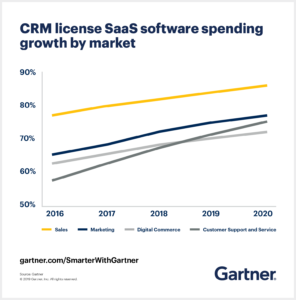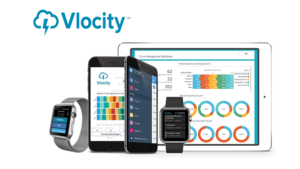Why We Invested in Vlocity
April 11, 2019
PUBLISHED BY Bruce Cleveland
SOURCE Wildcat Venture Partners
Some decisions are easier than others.
Unlike other investments we have made, we knew from the very beginning Vlocity would be a winner.
Why?
We use the four Traction Gap Framework pillars (Product, Revenue, Team and Systems) as an evaluation model when making investment decisions.
Vlocity was led by a seasoned pro, David Schmaier, who had captained the Products division of Siebel Systems – the company that created CRM. David and his organization built all of Siebel’s original horizontal and vertical CRM product offerings. Siebel was the fastest growing company in US history at the time – $0 to $2 Billion annual revenue in 5 years (more than 750,000% CAGR) and had reached a peak market cap of $29 Billion before its acquisition by Oracle in 2006. So, out of the four pillars, we knew Product, Team, and Systems were covered. Salesforce was also fully behind the company as a major investor and partner, so the fourth pillar, Revenue, was nailed.
With all four pillars covered, it was hard to envision Vlocity not succeeding.

When Vlocity recently raised a $60 Million Series C round of financing, establishing a $1 Billion valuation this reaffirmed the principles in the Traction Gap Framework.
While everyone seems to know the consumer startup “unicorns” few know their enterprise counterparts. Vlocity is a Forbes Cloud 100 company and one of Salesforce.com’s bigger – and one of its fastest growing – partners. They build, market, and sell industry-specific cloud and mobile CRM solutions that utilize the Salesforce horizontal platform.
MARKET OPPORTUNITY
Vlocity CEO David Schmaier was an early pioneer in the CRM space. He was a member of the original founding executive team at Siebel Systems. David and I worked together for many years at Siebel; David ran the Products organization and I ran Marketing and Alliances. He was (is) a phenomenal leader who had scaled with Siebel from its very early days. So, it was easy for us to have confidence in his executive and leadership capabilities.

Not long ago, David was looking to get back into the startup game, so he attended Salesforce’s “Dreamforce” conference and discovered Veeva – a company that delivers industry cloud solutions that provide data, software, services and an ecosystem of partners to support pharmaceutical and healthcare business functions. At the time, Veeva had become one of Salesforce’s more successful partners by helping companies of all sizes bring products to market faster and more efficiently while maintaining compliance.
This was David’s aha moment – when he realized that his vertical industry experience could be leveraged into a cloud offering that would cover not one core vertical, such as Veeva, but five. Vlocity now embeds industry-specific functionality including best practices and business processes for the Communications & Media, Insurance & Financial Services, Health Insurance, Energy and Public Sector industries. These pre-built apps enable companies to be more agile and deliver better time-to-value across digital and traditional channels.
According to a recent report by Gartner, in 2019 spending for SaaS-based CRM will reach approximately $42 billion and represent 75% of the total CRM software spend.

At Siebel, we learned that companies are far more willing to invest in SaaS-based CRM software when they can get access to vertically-focused solutions that are tailored for their industry, flexible in deployment, provide an overall increased business agility, and help deliver a better customer experience – at a significantly reduced total cost of ownership. The Vlocity team took the lessons they had learned at Siebel and built a suite of modern vertical solutions for the Salesforce platform.
THE PRODUCT
With its industry-specific cloud and mobile software, Vlocity helps drive digital transformation for the world’s largest companies and government entities including notable companies such as: New York Life, Cigna, Liberty Mutual, Colorado Department of Health Care, Delta Dental, and T-Mobile. And, they partner with Adobe, DocuSign, and NTT to name a few.

As an “industry cloud” pioneer, Vlocity was built in partnership with Salesforce, the global leader in CRM. Their cloud and mobile applications transform customer processes and experiences to improve overall engagement while easing deployment.
WHAT THIS MEANS
If we take a closer look at Vlocity’s journey from initial startup, we see the ideal case for the premise of my new book, Traversing the Traction Gap.
Too often, we’ve seen companies trip at each value inflection point along the Traction Gap Framework – Minimum Viable Category (MVC), Initial Product Release (IPR), Minimum Viable Product (MVP), Minimum Viable Repeatability (MVR), and Minimum Viable Traction (MVT).

David’s team has pegged each value inflection point and the four core architectural pillars of the Traction Gap enabling them to secure a C-round with the highest valuation and a minimum amount of dilution.
- Product Architecture. Not only is their product based on the success of SaaS-based CRM systems, it is built on the largest CRM platform in the world.
- Revenue Architecture. It’s a simple message – all the power of the Salesforce platform, priced similarly, verticalized so it is optimized for companies in specific industries, and endorsed and jointly sold in partnership with Salesforce.
- Team Architecture. Vlocity prides itself not only on award-winning technology, but also on the talent and experience of its team. The company is comprised of some of the most experienced executives in cloud computing and industry transformation.
- Systems Architecture. This team has experienced rapid growth in the past and knew how to prepare for those times when they’d need to scale.
This is an experienced team with previous success working together. They had a clear vision they felt they could execute and knew what they needed to traverse the Traction Gap from Ideation. Congratulations to David and the entire Vlocity Team!
